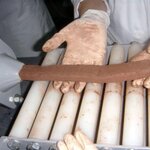Chemistry

A traditional Balkan bedbug remedy has been shown stab and trap the biting insects, according to a paper in the Journal of the Royal Society Interface.
Just in time, too. Bedbugs have made a dramatic comeback in the U.S. in recent years, infesting everything from homes and hotels to schools, movie theaters and hospitals. Although not known to transmit disease, their bites can cause burning, itching, swelling and psychological distress. It helps to catch infestations early, but the nocturnal parasites' ability to hide almost anywhere, breed rapidly and "hitchhike" from place to place makes…

New research hopes to create reactions necessary for industries such as pharmaceutical companies but eliminate the resulting waste from traditional methods.
Traditional methods – dating back thousands of years – involve using solutions to speed up chemical reactions that are used to make products that we use every day. However, the leftover waste or solvents can often be a volatile compound.
Disposal and recycling is also becoming a growing and more costly challenge for companies as they follow increasing federal environmental regulations.
Instead of using solutions to create…

If objects from space kindled life on Earth, how did it happen?
The terrestrial or extra-terrestrial case for important ingredients that led to the building blocks of life is a hot debate. A new paper says that adenosine triphosphate, similar to what is now found in all living cells and vital for generating the energy that makes something alive, could have been created when meteorites containing phosphorus minerals landed in hot, acidic pools of liquids around volcanoes, which were likely to have been common across the early Earth.
All life on Earth is powered by the process called…

Bodily fluids contain lots of information about the health of people, that is why medical doctors routinely have blood and urine analyzed.
But bodily fluids can do more than mark infectious diseases or cancer and organ failure, researchers at ETH Zurich and at the University Hospital Zurich have shown they can take advantage of modern high-resolution analytical methods to provide real-time information on the chemical composition of exhaled breath.
Yes, your breath has an identifiable individual chemical pattern. Call it a a 'breathprint'?
The scientists developed an instrument-based…

Since today is a celebration of St. Patrick, the religious figure who 'drove the snakes out of Ireland' (meaning Paganism), a whole lot of people got drunk last night.
Yeah, Protestants getting drunk the night before before a Catholic religious festival makes as much sense as anything else about St. Patrick's Day. In addition, kids in California get something magical in their shoes, which puzzles me too. I never heard of that when I was a kid but the rural area I grew up in was a delightful mix of people descended from residents of Scotland and Eastern Europe so there weren't a lot of…

Fluoride is good but too much of anything can be bad. However, a filter system developed in India using a medicinal herb is very, very good.
The technology uses parts of the plant Tridax procumbens as a biocarbon filter for the ion.
Drinking water can contain natural fluoride or fluoride might be added as a protective agent for teeth by water companies. In some natural drinking water, levels may be above those considered safe by the World Health Organisation. Chemist Malairajan Singanan of the Presidency College (Autonomous), in Chennai, points out that the WHO guidelines suggest that a safe…

Researchers analyzed strains of mold fermented in sourdough bread and were able to isolate natural compounds that can help keep bread fresh without changing its flavor, resulting in a tastier loaf.
Michael Ganzle, professor and Canada Research Chair in the University of Alberta Department of Agricultural, Food and Nutritional Science and fellow researchers say the natural compounds can replace preservatives added to store-bought bread which are safe to eat and extend shelf life, but alter the taste.
They say their research is the first to link the compounds—hydroxy fatty acids— to antifungal…

Researchers employing a century-old observational technique have determined the precise configuration of humulones, substances derived from hops that give beer its distinctive flavor.
That might not sound like a big deal but the findings overturn results reported in scientific literature for the last 40 years and could lead to new pharmaceuticals to treat diabetes, some types of cancer and other maladies.
"Now that we have the right results, what happens to the bitter hops in the beer-brewing process makes a lot more sense," said Werner Kaminsky, a University of Washington…

Northwestern University graduate student Jonathan Barnes and colleagues are the first to permanently interlock two identical tetracationic rings that normally are repelled by each other.
Some experts had said it couldn't be done.
On the surface, the rings hate each other because each carries four positive charges (making them tetracationic). But they discovered that by introducing radicals (unpaired electrons) onto the scene, the researchers could create a love-hate relationship in which love triumphs.
Unpaired electrons want to pair up and be stable, and it turns out the attraction of…

Researchers in Spain have mixed paper industry waste with ceramic material used in the construction industry and created a brick that has low thermal conductivity and so is a good insulator.
What's the catch? Its mechanical resistance still requires improvement.
The scientists collected cellulous waste from a paper factory (recycled) along with sludge from the purification of its waste water. In their laboratory they then mixed this material with clay used in construction and passed the mixture through a pressure and extrusion machine to obtain bricks.
"Adding waste means that the…